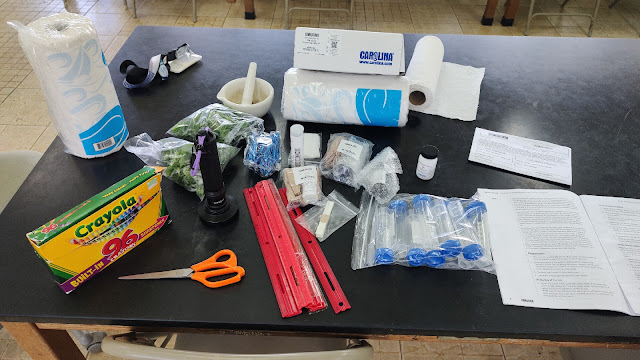Botany lab 14 Thin Layer Chromatography
This laboratory was based on a Carolina kit with future plans to substitute local solvents based on what the kit provides. The lab launched on two videos and a presentation. In retrospect the presentation was confusing and not helpful. From all appearances, the xanthophyll travelled further than the carotene, as least by color. Even if that were not true - suppose that lighter yellow was carotene and the orange was xanthophyll, that would be confusing as the students were taught xanthophylls are yellow and cartonoids tend to be more orange-yellow.
Lacking pencils, I opted for crayons. These worked far better than expected. Crayons are softer than pencils and do not damage the gel layer. The crayons did not appear to affect the chromatography and their dyes did not appear to bleed into the gel layer.
Added to the leaves prior to grinding was a dash of calcium carbonate and acetone. Calcium carbonate is widely available on island. Bags of lime are sold to accompany the chewing of betelnut. And acetone is fingernail polish remover. Both of these can be locally replenished.
The leaves were pounded and pulverized but never yielded a liquid that we could pull with the capillary tubes. I used cheesecloth to squeeze the pulp and that worked nicely. More cheesecloth will be needed in a future run. Or coconut tree petiole sheathing, possibly a white fabric.
The capillary tubes worked well enough.
Marks were recommended to be placed one centimeter from each end. When the pigment solution is applied at the one centimeter mark, then the chromatography tube can be
Devron marks his thin layer chromatography strip
Aleina marking her thin layer chromatography strip.
Half a sandwich bag of leaves produced an excess of fluid once squeezed. That surprised me.
The iso-octane and acetone mix moved faster and thus farther than the isopropanol solvent. The upside to the mix was, for one group, the apparent separation of chlorophyll a and b. The downside was that xanthophyll was smeared out to almost be invisible. The suggestion to use a UV light did not help, at least not in the brightness of A101. Isopropanol did not separate chlorophyll a and b, moved a smaller distance, but showed xanthophyll and carotene more clearly. The isopropanol was 70% isopropanol, which is widely available on island. I think I once saw 90% isopropanol on island. Perhaps pure acetone can be substituted for the mix, or perhaps some form of petroleum ether is available in some hardware store substance. Apparently the gas used in camping stoves might be a substitute - it is close to petroleum ether, another low molecular weight hydrocarbon. Petroleum spirits and mineral spirits might be two other options as a second solvent.
The tube were ideal. Solvent is filled only to the line at the top of the cone. The pigment dot remains above the solvent.
A typical iso-octance and acetone mix strip.
A typical isopropanol strip.
A closer look at the pigments.
The chromatograph in progress. This was taken around 12:40 PM.
Probably the mix.
Another isopropanol strip.
A strip where the solvent front was marked because the solvent did not reach the mark one centimeter from the end.
There was a lot of Alternanthera sisoo left at the end. The plant performed well. I am left wondering whether some other plant might be a useful addition.




















Comments
Post a Comment